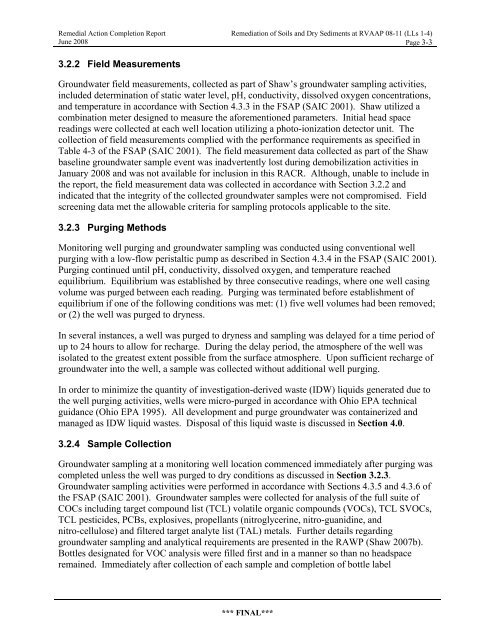Final Remedial Action Completion Report for the ... - Rvaap.org
Final Remedial Action Completion Report for the ... - Rvaap.org
Final Remedial Action Completion Report for the ... - Rvaap.org
You also want an ePaper? Increase the reach of your titles
YUMPU automatically turns print PDFs into web optimized ePapers that Google loves.
<strong>Remedial</strong> <strong>Action</strong> <strong>Completion</strong> <strong>Report</strong><br />
June 2008<br />
3.2.2 Field Measurements<br />
Remediation of Soils and Dry Sediments at RVAAP 08-11 (LLs 1-4)<br />
Page 3-3<br />
Groundwater field measurements, collected as part of Shaw’s groundwater sampling activities,<br />
included determination of static water level, pH, conductivity, dissolved oxygen concentrations,<br />
and temperature in accordance with Section 4.3.3 in <strong>the</strong> FSAP (SAIC 2001). Shaw utilized a<br />
combination meter designed to measure <strong>the</strong> a<strong>for</strong>ementioned parameters. Initial head space<br />
readings were collected at each well location utilizing a photo-ionization detector unit. The<br />
collection of field measurements complied with <strong>the</strong> per<strong>for</strong>mance requirements as specified in<br />
Table 4-3 of <strong>the</strong> FSAP (SAIC 2001). The field measurement data collected as part of <strong>the</strong> Shaw<br />
baseline groundwater sample event was inadvertently lost during demobilization activities in<br />
January 2008 and was not available <strong>for</strong> inclusion in this RACR. Although, unable to include in<br />
<strong>the</strong> report, <strong>the</strong> field measurement data was collected in accordance with Section 3.2.2 and<br />
indicated that <strong>the</strong> integrity of <strong>the</strong> collected groundwater samples were not compromised. Field<br />
screening data met <strong>the</strong> allowable criteria <strong>for</strong> sampling protocols applicable to <strong>the</strong> site.<br />
3.2.3 Purging Methods<br />
Monitoring well purging and groundwater sampling was conducted using conventional well<br />
purging with a low-flow peristaltic pump as described in Section 4.3.4 in <strong>the</strong> FSAP (SAIC 2001).<br />
Purging continued until pH, conductivity, dissolved oxygen, and temperature reached<br />
equilibrium. Equilibrium was established by three consecutive readings, where one well casing<br />
volume was purged between each reading. Purging was terminated be<strong>for</strong>e establishment of<br />
equilibrium if one of <strong>the</strong> following conditions was met: (1) five well volumes had been removed;<br />
or (2) <strong>the</strong> well was purged to dryness.<br />
In several instances, a well was purged to dryness and sampling was delayed <strong>for</strong> a time period of<br />
up to 24 hours to allow <strong>for</strong> recharge. During <strong>the</strong> delay period, <strong>the</strong> atmosphere of <strong>the</strong> well was<br />
isolated to <strong>the</strong> greatest extent possible from <strong>the</strong> surface atmosphere. Upon sufficient recharge of<br />
groundwater into <strong>the</strong> well, a sample was collected without additional well purging.<br />
In order to minimize <strong>the</strong> quantity of investigation-derived waste (IDW) liquids generated due to<br />
<strong>the</strong> well purging activities, wells were micro-purged in accordance with Ohio EPA technical<br />
guidance (Ohio EPA 1995). All development and purge groundwater was containerized and<br />
managed as IDW liquid wastes. Disposal of this liquid waste is discussed in Section 4.0.<br />
3.2.4 Sample Collection<br />
Groundwater sampling at a monitoring well location commenced immediately after purging was<br />
completed unless <strong>the</strong> well was purged to dry conditions as discussed in Section 3.2.3.<br />
Groundwater sampling activities were per<strong>for</strong>med in accordance with Sections 4.3.5 and 4.3.6 of<br />
<strong>the</strong> FSAP (SAIC 2001). Groundwater samples were collected <strong>for</strong> analysis of <strong>the</strong> full suite of<br />
COCs including target compound list (TCL) volatile <strong>org</strong>anic compounds (VOCs), TCL SVOCs,<br />
TCL pesticides, PCBs, explosives, propellants (nitroglycerine, nitro-guanidine, and<br />
nitro-cellulose) and filtered target analyte list (TAL) metals. Fur<strong>the</strong>r details regarding<br />
groundwater sampling and analytical requirements are presented in <strong>the</strong> RAWP (Shaw 2007b).<br />
Bottles designated <strong>for</strong> VOC analysis were filled first and in a manner so than no headspace<br />
remained. Immediately after collection of each sample and completion of bottle label<br />
*** FINAL***











